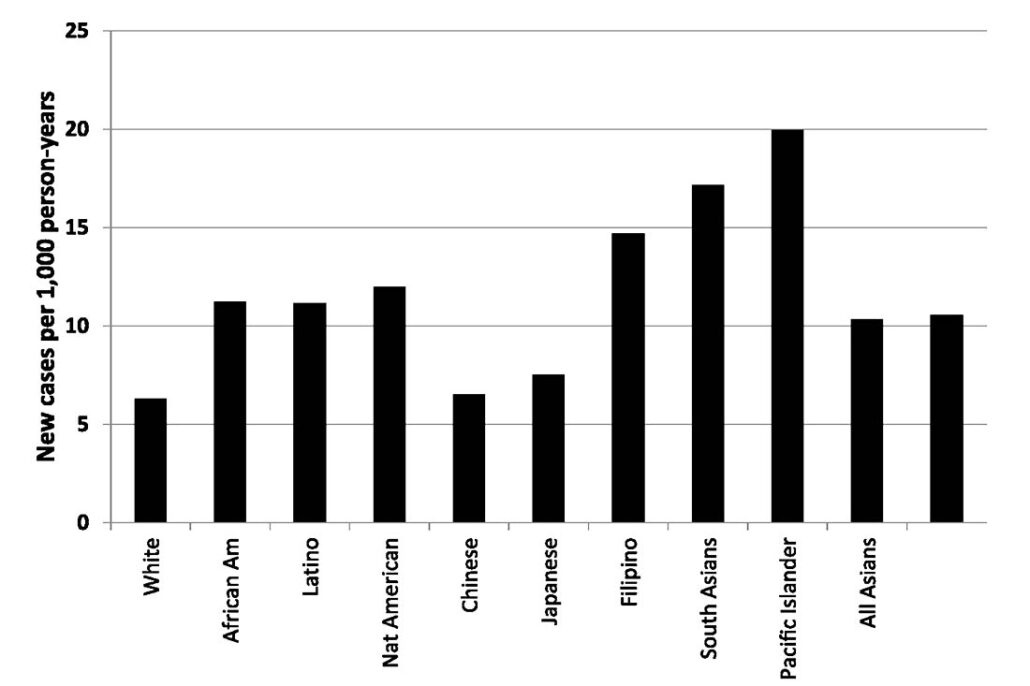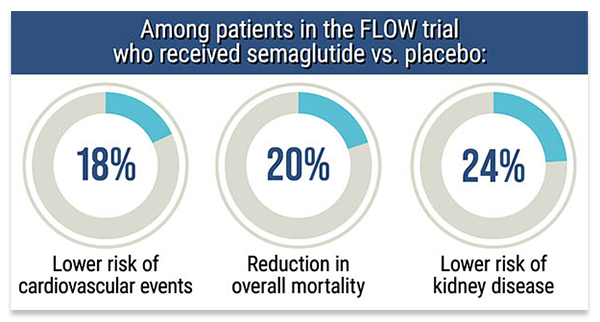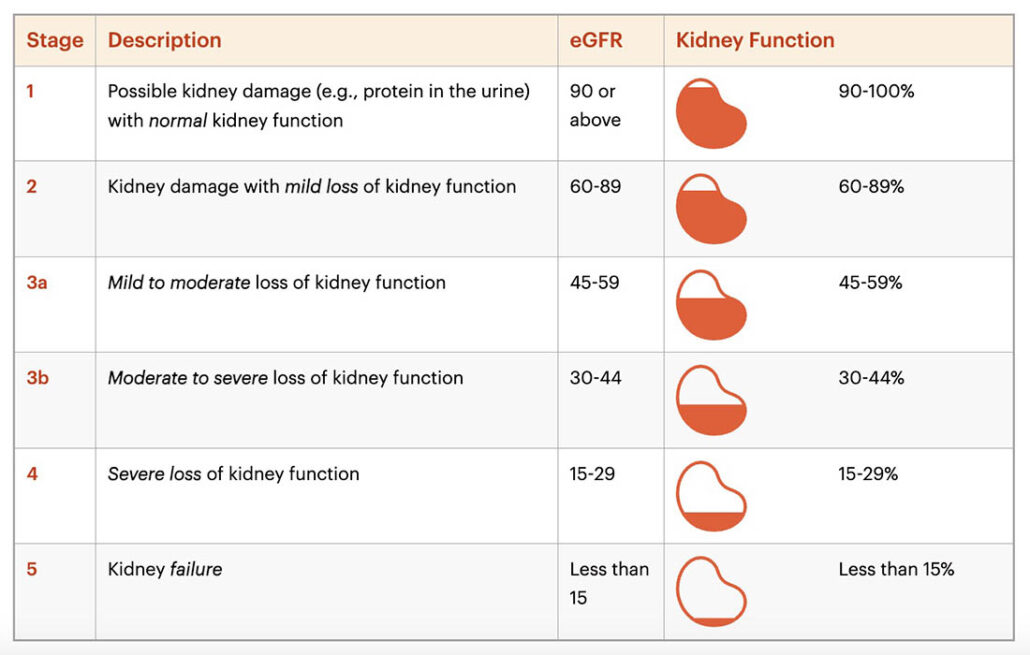
Reading Time: 4 minutes
I wanted to highlight this case because kidney disease is unfortunately very common in people with diabetes, and in the old days there weren’t preventive measures.
In the last few years though, we have had several new medications approved to prevent the progression to chronic kidney disease (CKD). Trust me, you do not want to be on dialysis or need a transplant. (If you do though, life is not over!) The good news is we have many pillars of therapy now to treat people with diabetes and kidney disease.
The Patient: Type 2 Diabetes with Multiple Metabolic Conditions
Leilani is a 56-year-old Hawaiian woman who was first diagnosed with type 2 diabetes at the age of 48. She has a very strong family history of the condition – her mother, father, sister, two uncles, and an aunt all have type 2 diabetes.
Native Hawaiians and Pacific Islanders are three times more likely to be diagnosed with type 2 diabetes compared to non-Hispanic whites. This is due in part to a higher prevalence of risk factors in this population.
Some of the risk factors include:
- Genetic Predisposition: Native Hawaiians and Pacific Islanders have a higher genetic susceptibility to insulin resistance
- Obesity: Higher rates of overweight and obesity, especially central obesity
- Diet: High consumption of processed foods, sugary drinks, and refined carbohydrates contributes to insulin resistance
- Physical Inactivity: Sedentary lifestyles can lead to lower insulin sensitivity
- Socioeconomic Factors: Limited access to healthcare, healthy food options, education, and preventive care
- High Rates of Metabolic Syndrome: A cluster of conditions like high blood pressure, high blood sugar, and excess abdominal fat

Leilani also has high blood pressure, abnormal cholesterol levels with a high LDL, fatty liver disease (now referred to as metabolic dysfunction-associated steatotic liver disease or MASLD) which was diagnosed recently from an elevated liver function test, and chronic kidney disease (CKD).
Leilani’s Type 2 Diabetes Medication Regimen
Leilani is on the following medications:
- An ACE inhibitor for high blood pressure
- A statin for cholesterol
- An SGLT2 inhibitor called Farxiga for glucose control and CKD
- Kerendia
Kerendia is a relatively new type 2 diabetes medication that’s also used to prevent the progression of diabetic kidney disease.
Leilani’s average blood pressure is 125/80 mmHg and her LDL is 85. Her blood pressure should be below 125/80 mmHg consistently, and her LDL should be below 70. Her A1c is 8.2%, which hasn’t changed much over the last year.
The Problem: Type 2 Diabetes Complications – Metabolic Syndrome and Diabetic Kidney Disease
Leilani’s most recent blood work showed that her eGFR (estimated glomerular filtration rate) dropped from the 70-80 range down to 55. The eGFR is a measurement that estimates how well your kidneys are filtering waste from your blood.
Stages of Chronic Kidney Disease:
Her uACR (urine albumin-creatinine ratio) also went up into the abnormal range to 45, whereas before it was below 30. Your uACR results show how much protein is in your urine, which helps measure kidney health. A lower number is better – ideally lower than 30.
uACR Results:

The Solution: How to Treat Diabetes and Kidney Disease
Because Leilani has type 2 diabetes, several conditions related to metabolic syndrome (hypertension, abnormal cholesterol, fatty liver disease and obesity), and now the onset of diabetic kidney disease despite medication, we need to do everything we can to reduce the progression of kidney disease.
The first thing to focus on is glucose control, followed closely by blood pressure control.
On Leilani’s most recent visit I added Ozempic to her regimen, which will not only improve her glucose levels and reduce excess weight, but will also have beneficial effects on reducing the progression of diabetic kidney disease.
What is Ozempic? Ozempic is a GLP-1 RA medication that recently received a new indication by the FDA to reduce the risk of worsening kidney disease. Ozempic is the first diabetes medication in its class to receive this designation. The approval was based on results from the FLOW clinical trial that showed Ozempic lowered the risk of major kidney disease-related events by 24% in people with type 2 diabetes and chronic kidney disease. Just one of many Ozempic benefits.

We expect Leilani to do extremely well over the long term, and we will follow her closely.
6 Pillars of Therapy to Prevent the Progression of Chronic Kidney Disease
With the addition of Ozempic to Leilani’s diabetes medication regimen, all the pillars of therapy are now in place to prevent the progression of CKD to avoid dialysis or transplantation.
The 6 pillars of therapy are:
- Glucose control
- Blood pressure control
- Use of ACE inhibitors or ARBs
- SGLT inhibitors
- Kerendia
- Ozempic
Diabetes and Kidney Disease: The Takeaway
People with type 2 diabetes very often have multiple metabolic problems, so the conditions that make up the metabolic syndrome need to be addressed and treated.
The treatment approach involves controlling blood sugar, blood pressure, weight, and cholesterol levels. This will have lasting beneficial effects not only on diabetes and heart disease, but on kidney disease as well.
It’s very important to keep an eye on the tests that indicate the health of your heart and kidneys because there are no symptoms of heart and kidney disease in the early stages.
As we know, the heart and the kidneys are like a married couple – in sickness and in health, ‘til death do they part! This is one marriage you want to succeed, unlike your last one…or two!
For more tips on how to protect your heart and to learn more about type 2 diabetes and kidney disease, visit our educational resources and TCOYD® video vault.
Additional Resources:
- Protect Your Heart and Kidneys: Essential Guide for People with Diabetes
- How Cardiovascular-Kidney-Metabolic Syndrome Affects People with Diabetes
- What to Know about MASLD and MASH: Two Liver Conditions that Can Affect People with Diabetes
- Live Long and Prosper with Kerendia, a New Medication for Type 2 Diabetes



Awesome summary of a very common and super serious complication of diabetes.
Am grateful for your informative programs, case studies, etc. Education re our disease, whether Type 1 or 2, is imperative to our control and good health.
Thanks so much.
Thanks for your comment, Barbara. Appreciate it!
I am a physician but also a recent type 1 diabetic (LADA got me age 37), and I found this case beneficial for my practice and information for myself in the future. Thank you for sharing the knowledge wealth!
Thanks Mona – appreciate it!
How relevant is Kerendia for those of us with T1D and CKD? Would insurance in the US even cover that?
Thank you for that question. Unfortunately since it’s not approved for use in type 1 yet (there is a study going on now), it may not be covered. However, I do feel it would be just as effective in type 1 diabetes.
I am referring to kidney disease, stage 3b with NO diabetes.
The pillars of therapy should work for you as well.
Thanks for the information.
I tried kerendia (10 mg) for 10 days and my Nephrologist stop it as I was having a negative reaction. My blood pressure went very low and my hart beat went high. I was feeling light headed most of the time and I always struggled with fatigue.
I wish that there’s an alternative medication that I can use.
At present my A1C is 6.3. My glucose is well managed (Ave. 142) with Metformin (1000 mg) 2x/day. I’m on Brenzavvy (20 mg)/day. Average cholesterol was 159.
Hi Roland,
Make sure you do all the other preventative therapies listed in the case study article.
I also had a bad experience with kerendia. My doctor switched me over to Jardiance and it seems to be working well.
Glad you found a medication that’s working well for you, Kenneth.
Does it work if your already on dialysis
Unfortunately you’ve already reached end-stage kidney disease, but all of the techniques we mention in this article do keep you healthier in general.